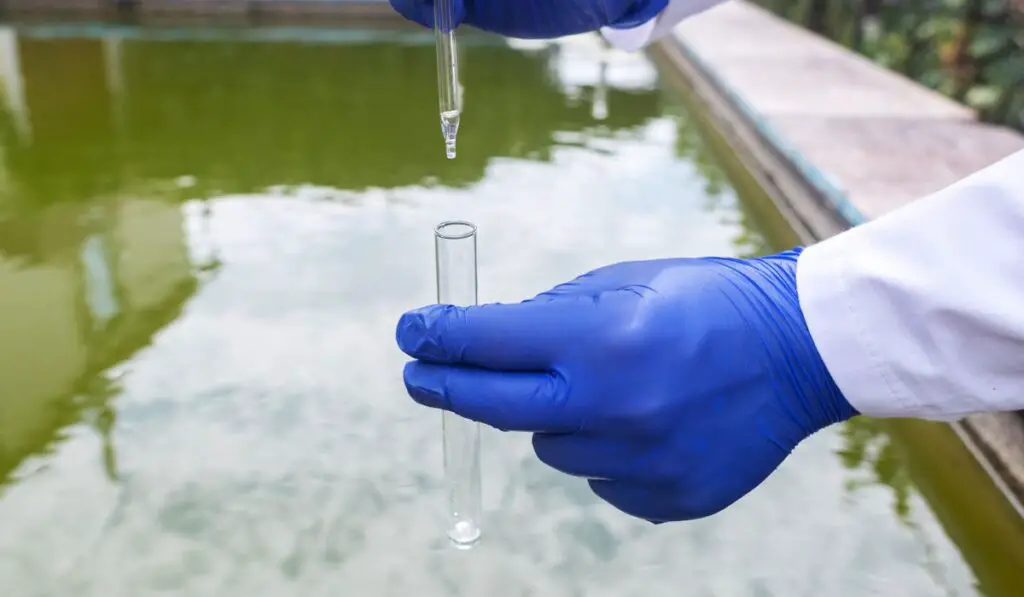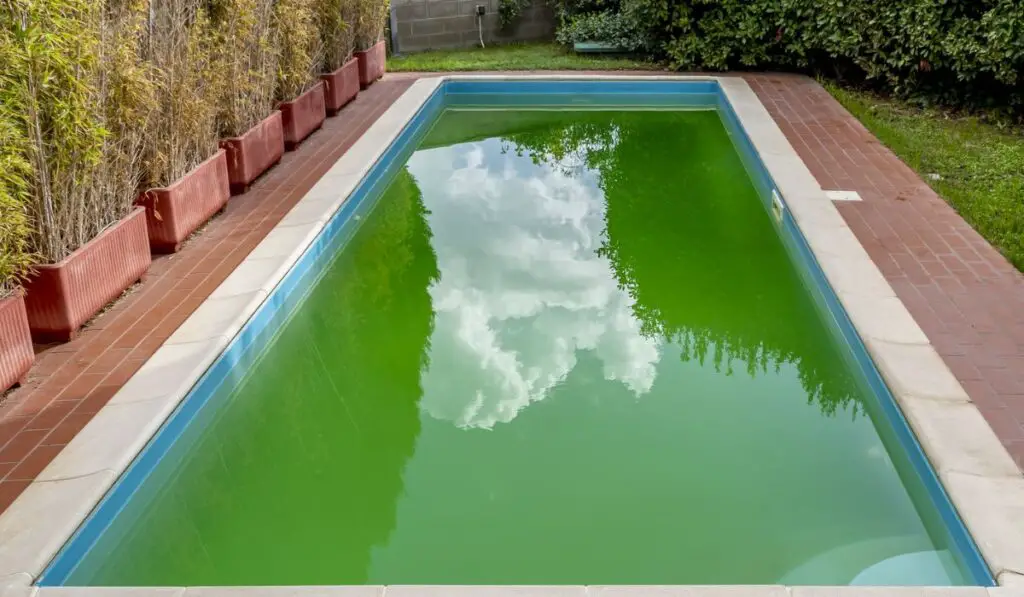Owning a pool can be a fun and relaxing way to pass the warm summer months. But what happens when your pool turns yellow? Can you still swim?
Yellow pool water is caused either by mustard algae, or high metal content in your pool water. Mustard algae is gross and slimy and makes the water unsafe to swim. In either case, you should treat your pool using chemicals like shock treatment to correct the problem, before you go for a dip.
Wondering what chemicals you should use to rid your pool of algae? Let’s look at what causes yellow pool water as well as the chemical and natural solutions available.
What Causes Yellow Pool Water?

Yellow pool water is often caused by algae growth. This type of algae is called mustard algae and it is known to be resistant to chlorine as well as other pool sanitizers.
Unlike traditional algae which tends to grow on the surface of your pool water, mustard algae are slimy and grow on the sides and bottom of the pool. This makes it difficult to access, and as a result, difficult to get rid of.
Yellow algae grow because of a chemical imbalance in your pool, most notably high pH levels. But this isn’t the only reason yellow algae may begin to grow.
Dust, debris and even plant pollen can lead to the growth of yellow algae in your pool. If you live in a warm climate, this is even more of an issue than it is for those with a pool in a cooler climate.
If you have inspected your pool and don’t see any algae, there is one more culprit of yellow pool water and this is water that has a high metallic content. Iron, which is commonly found in well water, can change colors when it is exposed to the wrong levels of certain chemicals.
No matter if you have mustard algae or water with a high metal content, if you have yellow pool water, it means the chemicals in your pool are unbalanced and will need treatment to return to normal.
What Are the Best Methods for Treating Yellow Pool Water?
If you have come home to find your pool yellow, don’t panic, as there are many methods that can be used to treat yellow pool water.
Shocking the Pool
One of the best ways to correct a yellow pool is by applying a shock treatment to the water. If your pool is infested with mustard algae, this will help kill the algae. Do note, however, that it may take several treatments, and brushing, to rid your pool of algae.
If your yellow water is due to metals in the water, then a shock treatment will make the discoloration worse. This is why you should find the source of your yellow water before beginning to treat it.
Using Algaecides
If you know for a fact you have mustard algae, then you need to apply an algaecide to your pool. These are strong chemicals that can kill algae.
You will need to ensure you buy a product that is for mustard algae (on Amazon) however, as it is much more difficult to kill than green algae. Most brands specify on the bottle whether they kill green, yellow, or black algae, or all three.
Metal Treatment
If your pool is yellow due to metal content, you will need to complete a pool ionizing treatment. This treatment will bond the bits of metal with other chemicals so they can be removed from the pool.
If you struggle with metal content in your water frequently, a pool ionizer (on Amazon) might be a good idea to install in your pool to keep the metal content at bay.
How to Prevent Yellow Pool Water

As a pool owner, the last thing you want to do is not be able to swim in your pool due to yellow water. The good news is, there are several methods to prevent the water in your pool from turning yellow.
Regular Pool Maintenance
Oftentimes, regular pool maintenance is enough to deter algae from growing in your pool. Regular pool maintenance includes:
- Running a pool vacuum a few times a week.
- Brush your pool sides, lights, and bottom with a pool brush once or twice a week.
- Remove any debris floating in the pool.
- Clean all pool toys or other items which come in contact with your pool water.
While this may seem like a lot to do to keep your pool in tip-top shape, this maintenance is imperative for keeping your pool safe for swimming.
Proper Chemical Balance
When you installed a pool, you probably didn’t expect to become a chemist, but maintaining proper chemical balance in your pool is essential to preventing yellow pool water.
You should plan to test your pool water using a digital testing kit (on Amazon), or testing strips (on Amazon), at least once per week. You’ll want to keep the pH at 7.2-7.4 and the Alkalinity between 60-120 ppm.
You will also want to test calcium hardness as well as the phosphate content of your pool water.
Filtration System Upkeep
A major cause of algae is improper pool filtration. Even if you aren’t using your pool every day, you should plan to run the filtration system as much as possible–at least 12 hours a day.
Many people choose to leave their pool filtration running all the time to lower the chances of algae growth. You should also ensure you follow all manufacturer recommendations for filtration system cleaning and replacement.
Algae Prevention
Beyond just running your filter and checking the chemicals, you’ll want to use some algae prevention methods on a regular basis. This can include adding an algaecide (on Amazon) to your water with some regularity.
You shouldn’t add algaecide all the time, but purchase a bottle and add it as often as recommended for prevention. This could be on a weekly, bi-weekly, or monthly basis.
Metal Content Prevention
Metal gets into your pool through the water you put in it (common with well water) as well as through the deterioration of metal pipes and other pool equipment.
To prevent too much metal from getting into your water and turning the pool yellow, it is important to keep all aspects of your pool in good condition. If you begin to notice erosion, replace the eroding parts right away.
Algaecide and pool shock treatments can also add metals to your pool water. The best way to remove them in this case is to add ionizers to help remove some of the excess metal content.
What Are the Best Natural Alternatives?
As you have noticed, there are many chemicals involved in keeping your pool water clean. If you don’t feel comfortable using pool chemicals, you may wonder if there is a more natural remedy for ridding your pool of yellow water.
Unfortunately, yellow pool water is typically a sign of a serious problem, therefore it is not recommended to use natural remedies to resolve it.
If your pool water is yellow from metal content, then a pool ionizer can be a non-chemical option for getting the color back to normal. But, if you have mustard algae growth, you will need to shock your pool and add algaecide in order to make the pool swimmable again.
When to Call a Professional
If you have tried everything to get your pool water back to its beautiful blue color, and it’s still yellow, then it is a good idea to contact a professional for help. They may have additional tools and advice to get rid of your yellow pool water.
